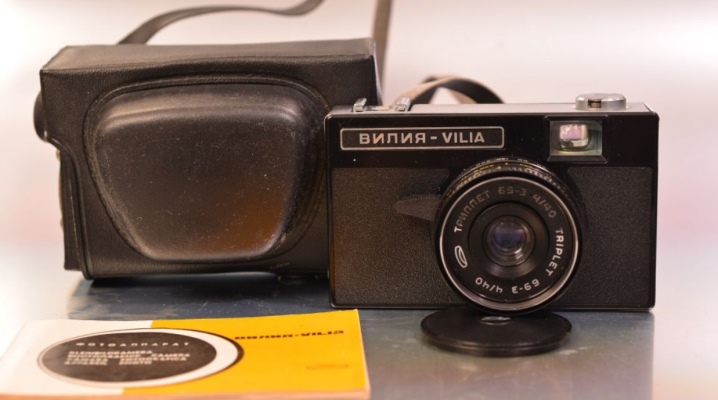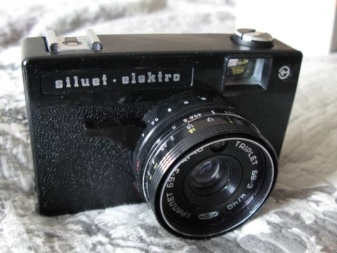Review of cameras "Viliya"

From the beginning of the 70s to the mid 80s of the last century, the school camera "Viliya" was produced in the Soviet Union. Due to the reasonable cost and the large number of manufactured products, such devices were very popular among photography enthusiasts. Features, lineup, instructions for use - in the review of cameras "Viliya".
Peculiarities
The Viliya camera is equipped with a 3.5 cm wide film with a frame size of 2.4x3.6 cm. The camera has a Triplet-9-3 4/40 mm lens. This unit is equipped with an optical viewfinder that has a backlit frame to indicate frame boundaries.
The automatic exposure control works thanks to the selenium exposure meter. Aperture shutter processing is displayed in the viewfinder using a galvanometer arrow. If the automatic mode is off, you can select the aperture manually at a stable shutter speed of 1: 30. Equipment dimensions: 7.2x8.5x12.8. Weight 0.45 kg. The device works without batteries, its automation is triggered by an element of selenium, which is located on the lens near the lens.


Model overview
The Viliya line included 4 modifications.
- "Vilia-Vilia" - a model where the regulation of the amount of light passing through the diaphragm and entering the matrix to form a picture is done manually.
- "Viliya-Auto" - was a software device. The exposure mechanism in automatic mode could change both the shutter speed and the aperture.
- "Silhouette-Electro" - a device where the main element was the diaphragm.
- "Orion EE" - a device where exposure is in the first place.




The devices are named differently, but are variants of the same camera. Interesting that functions, which in modern cameras are carried out by switching the appropriate modes, in the last century required the release of 4 cameras. The body of the cameras is unified, the lenses are identical. The cameras under consideration had differences, consisting not only in the procedure for regulating the amount of light falling on the matrix, but also in the equipment of the light detector.


"Vilia-Vilia" was produced in the 70-80s of the last century by an optical-mechanical association in Belarus. The later version was called "Viliya-Auto". More than 3 million units were produced at that time.
Device case "Viliya-Auto" was made of plastic, and the ends were decorated with gray steel inclusions. The front and rear panels had deep grooves that allowed the camera to be held securely in the hand.
On the front side of the camera there is a lens and a rather large viewfinder eye (on the left side). And a large shutter button on the right. The location of the button is very inconvenient - at the bottom and with a long stroke.

On the back there are:
- viewfinder window;
- film susceptibility mechanism;
- steel key for shutter control and frame transport;
- there is a reminder of the types of film on the hinged back cover.
The viewfinder of this camera model is highly informative. It provides a large-scale image with noticeable distortion. You can see the device holding the photo paper on the enlarger table with parallax adjustment up to 80 cm, as well as the exposure scale with an arrow on the right.


The scale contains shutter speed and aperture, which allows you to monitor the work of the latter. At the bottom of the camera are located:
- tripod socket;
- shutter off key when rewinding the film;
- frame counter window.
In the left end there is a hole for a wired sync contact and a back cover lock. Above the device is equipped with a mechanism for rewinding the film with a folding tape measure and a device for flash.

Automation is controlled by a small lever located at the bottom of the lens. If the lever is in mode A, the unit will automatically adjust the exposure. "Silhouette-Electro" - a kind of cameras "Viliya". The device belongs to small format school cameras. Complete set with 1.35 m film in cassettes. Frame size 2.5x3.6 cm.
The product is presented in a plastic case with a hinged cover made of the same material. The lid is equipped with a scale-reminder of light sensitivity, filled with film. There is a non-removable take-up spool. The frame counter has an automatic reset function when the back cover is opened.
The device is equipped with a non-removable lens. The size of the thread for fixing the light filters is 46x0.75 mm. The four-blade diaphragm is located behind the main shutter. The level of sharpness is adjusted by the scale of symbols and distances. The shutter is two-leaf, it works with the help of electronic control.


The power sources are 4 D-0.06 or RC-53 batteries. "Orion EE" - a device where the operation of the diaphragm is carried out using automation. It belongs to small-format school cameras, the features of which are similar to those of the equipment included in the Viliya line. Its main difference is that it is a shutter-priority device, in which the amount of light entering the matrix is automatically controlled, and the aperture value is also determined in automatic mode, which corresponds to the shutter speed adjusted manually.

Instructions
Before using the device, you should read the instructions for it. It should be remembered that the device is equipped with a non-removable lens, and any attempt to remove it may damage the device. First, you need to load the cassette, and charging is done in complete darkness. The film should be wound so as not to allow contact with the emulsion layer.
The camera should be charged as follows:
- by pressing the lock latch, the back cover of the device opens;
- after pulling out the rewind tape, you need to insert a standard cassette with a film, and set the tape to its original position;
- thread the end of the film into the hole of the take-up spool, and at the same time make sure that the tooth of the latter enters one of the perforations;
- it is necessary to check that the film lies without distortions, and the teeth of the conveyor sprocket enter all perforations.
- now you can close the lid and rewind the exposed area of the film.
The device requires careful handling. It should be kept clean and free from damage and extreme temperature fluctuations. It is forbidden to disassemble the camera, as this may compromise the integrity of individual components.


The following video provides an overview of the "Viliya" camera.













The comment was sent successfully.